Abstract
Inactivation of gentamicin (G) is known to occur secondarily to the formation of complexes with certain beta-lactam antibiotics. However, aminoglycosides in the presence of aminoglycoside-beta-lactam complexes may not be recognized uniformly by all assay methods. We tested this hypothesis by using mixtures of G plus carbenicillin (C), with and without the addition of penicillinase, in pooled sera under several in vitro conditions: at 25 and 35 degrees C and at low and high C concentrations. Samples were assayed for G with the EMIT and TDx systems, and a microbiological assay was performed with a strain of Klebsiella pneumoniae resistant to C. In the presence of C (500 micrograms/ml) at 35 degrees C, the initial G concentration of 5 micrograms/ml decreased markedly over 48 h as assessed by all three assay methods. However, significantly greater degradation was noted when samples were measured by microbiological assay and TDx than by EMIT. Differences between assays were less marked when mixtures were studied at a lower temperature and with a lower G to C ratio (5 micrograms of G plus 100 micrograms of C per ml). The addition of penicillinase to the antibiotic mixtures prevented the degradation of G over time when measured by all three assay systems. We concluded (i) that EMIT measures higher serum concentrations of G than do TDx or microbiological assays when complexes of G and C are present and (ii) that the addition of penicillinase to serum samples containing C and G would be effective in preventing G degradation during prolonged (greater than 24-h) periods between the time of sampling and assay.
Full text
PDF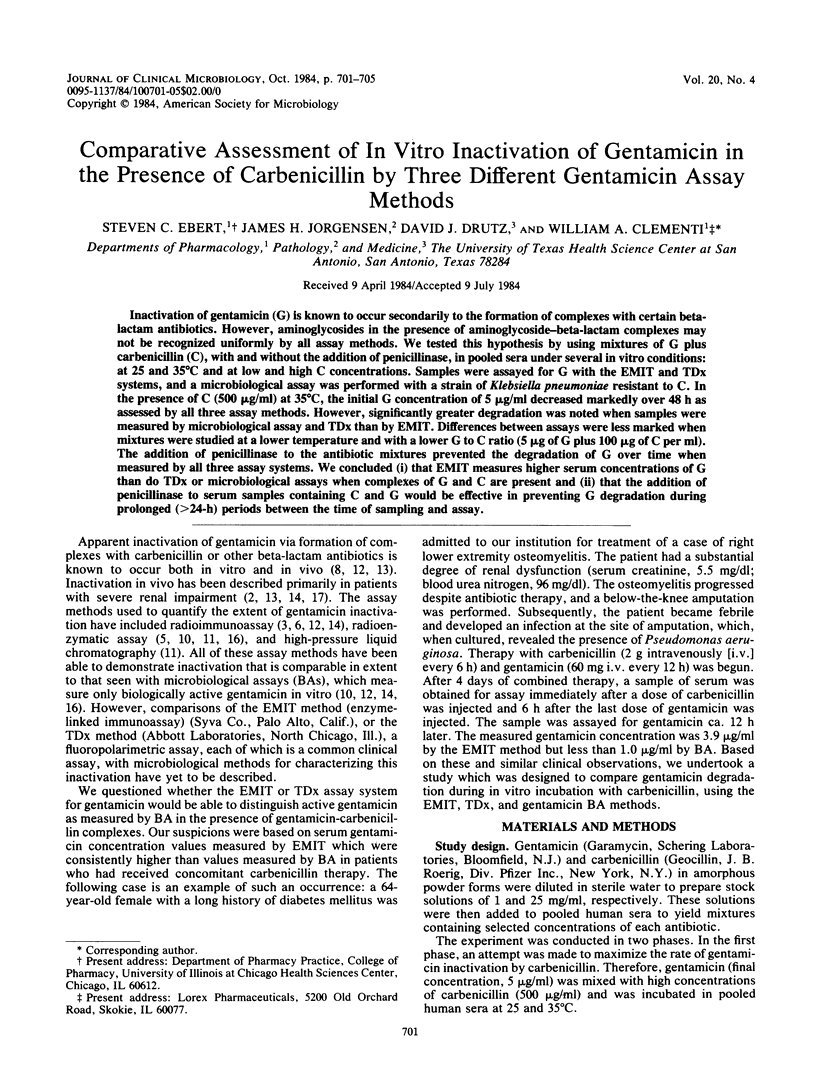
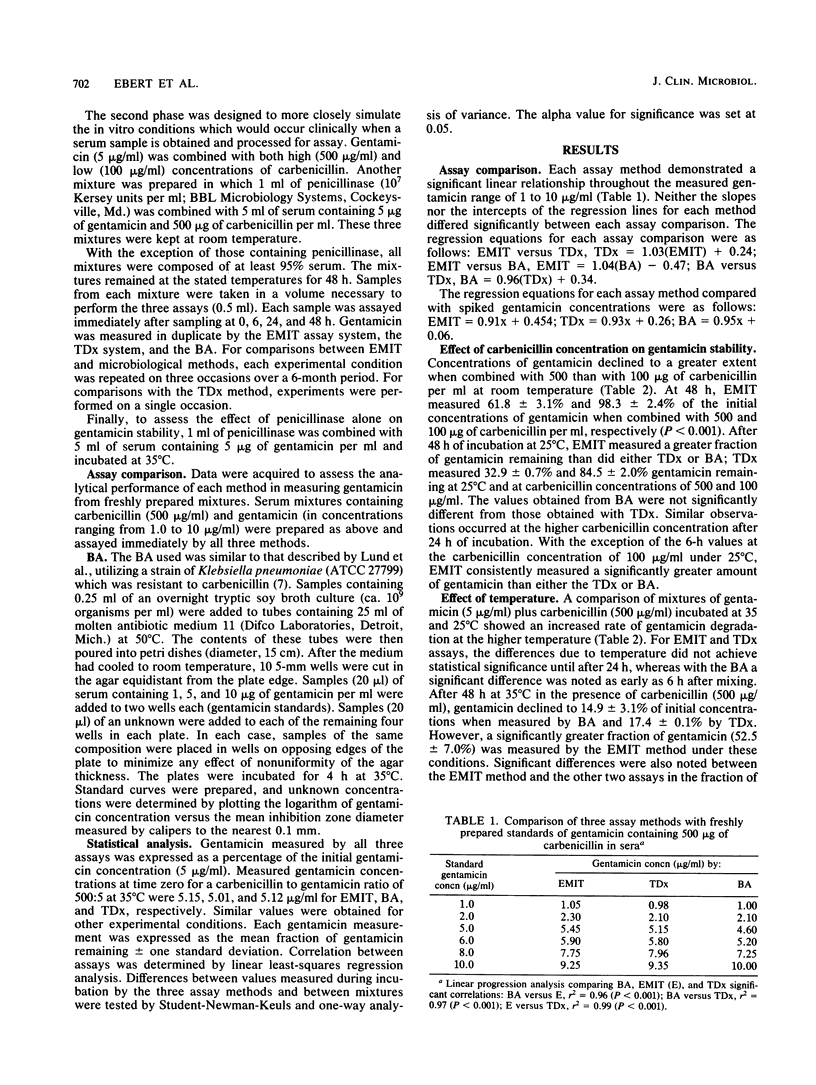
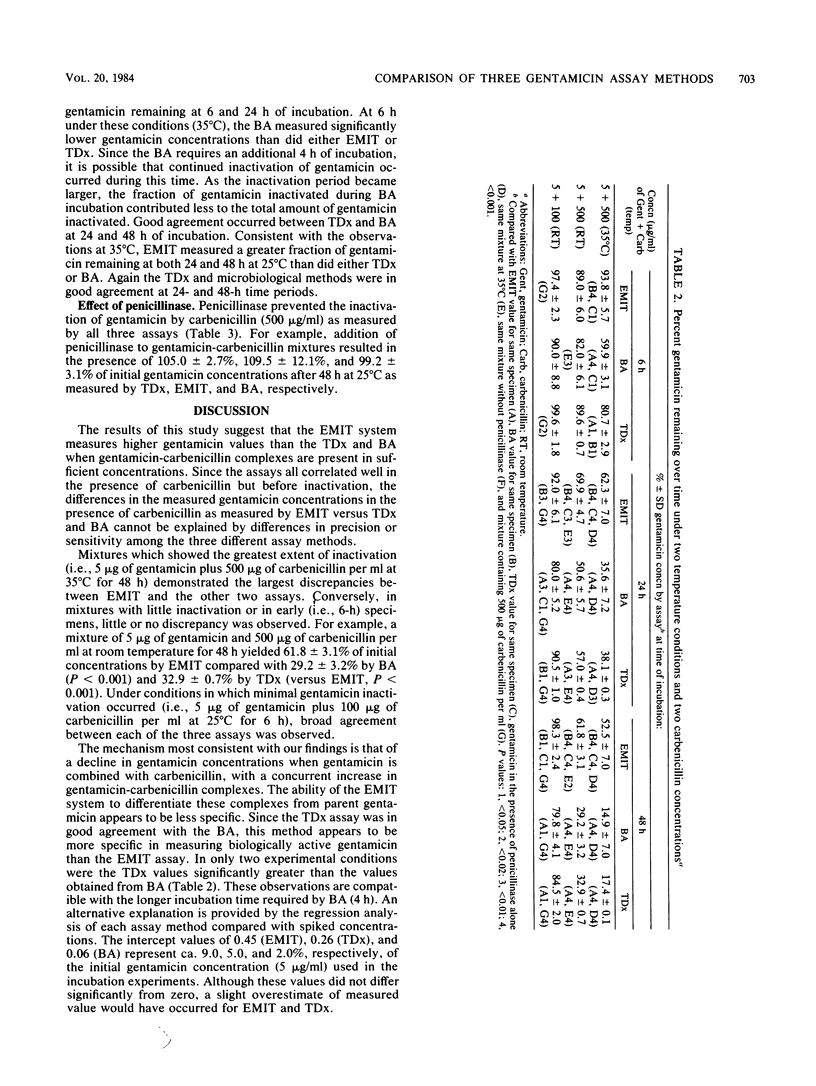
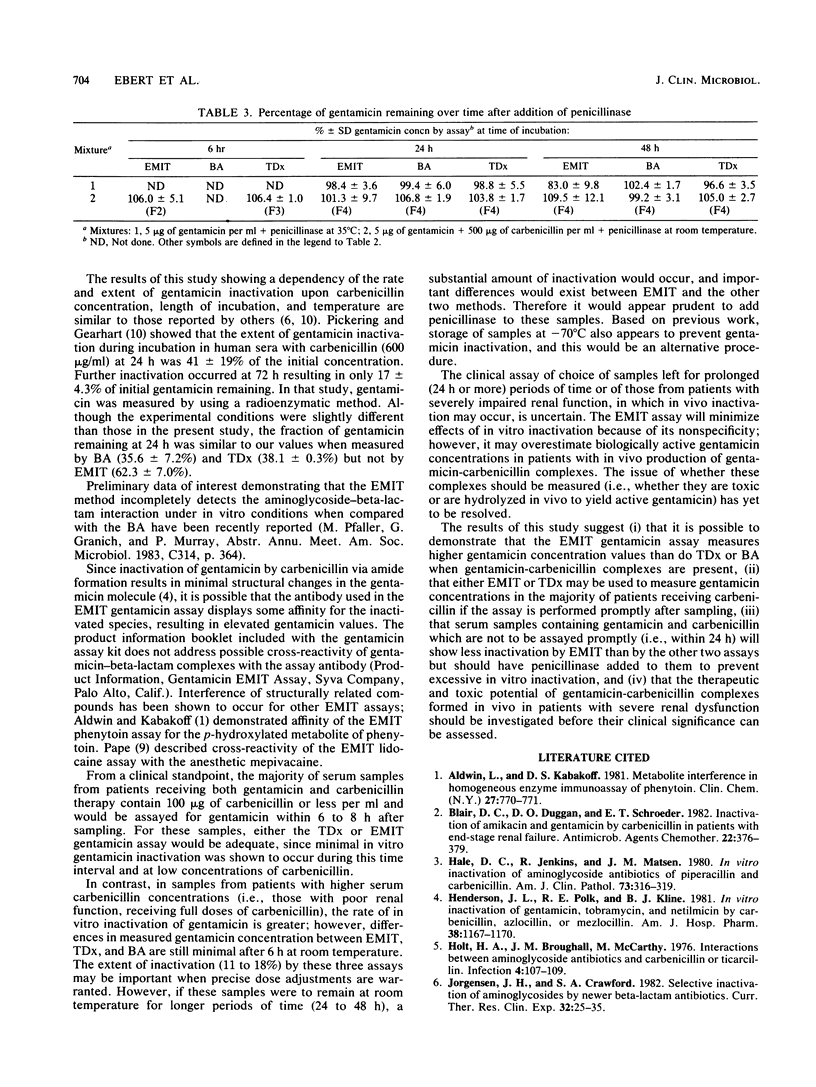
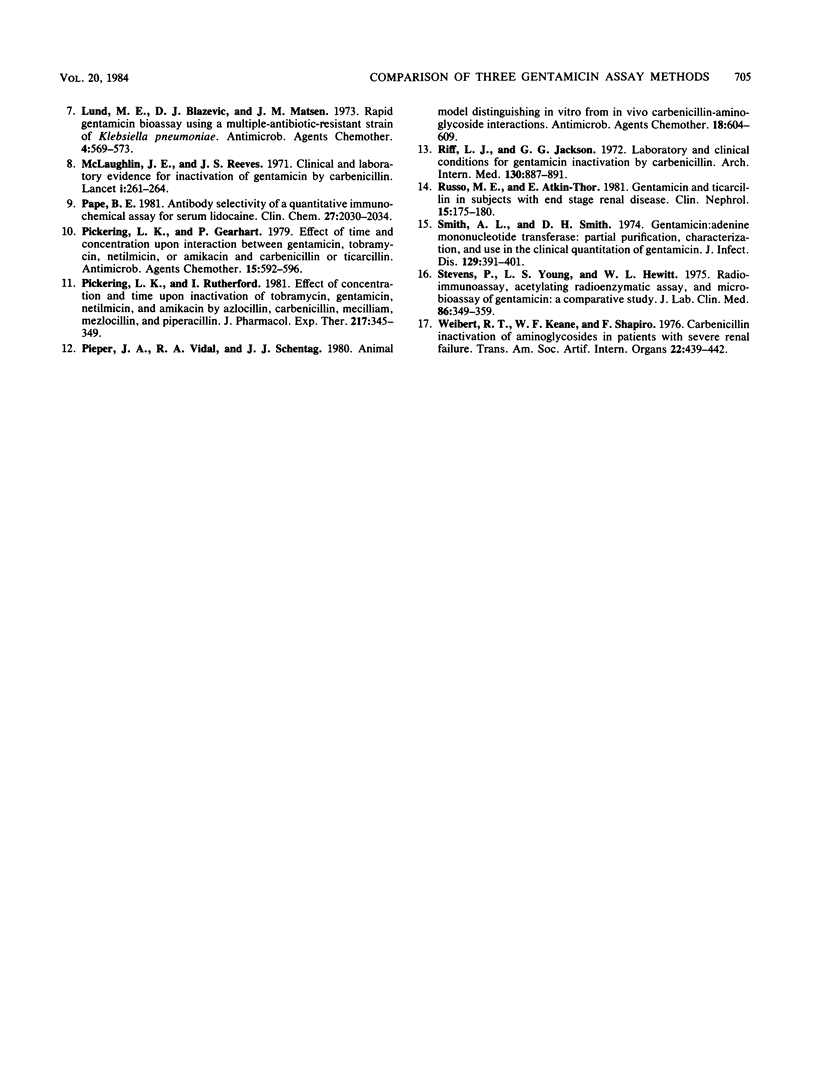
Selected References
These references are in PubMed. This may not be the complete list of references from this article.
- Aldwin L., Kabakoff D. S. Metabolite interference in homogeneous enzyme immunoassay of phenytoin. Clin Chem. 1981 May;27(5):770–771. [PubMed] [Google Scholar]
- Blair D. C., Duggan D. O., Schroeder E. T. Inactivation of amikacin and gentamicin by carbenicillin in patients with end-stage renal failure. Antimicrob Agents Chemother. 1982 Sep;22(3):376–379. doi: 10.1128/aac.22.3.376. [DOI] [PMC free article] [PubMed] [Google Scholar]
- Hale D. C., Jenkins R., Matsen J. M. In-vitro inactivation of aminoglycoside antibiotics by piperacillin and carbenicillin. Am J Clin Pathol. 1980 Sep;74(3):316–319. doi: 10.1093/ajcp/74.3.316. [DOI] [PubMed] [Google Scholar]
- Henderson J. L., Polk R. E., Kline B. J. In vitro inactivation of gentamicin, tobramycin, and netilmicin by carbenicillin, azlocillin, or mezlocillin. Am J Hosp Pharm. 1981 Aug;38(8):1167–1170. [PubMed] [Google Scholar]
- Holt H. A., Broughall J. M., McCarthy M., Reeves D. S. Interactions between aminoglycoside antibiotics and carbenicillin or ticarillin. Infection. 1976;4(2):107–109. doi: 10.1007/BF01638726. [DOI] [PubMed] [Google Scholar]
- Lund M. E., Blazevic D. J., Matsen J. M. Rapid gentamicin bioassay using a multiple-antibiotic-resistant strain of Klebsiella pneumoniae. Antimicrob Agents Chemother. 1973 Nov;4(5):569–573. doi: 10.1128/aac.4.5.569. [DOI] [PMC free article] [PubMed] [Google Scholar]
- McLaughlin J. E., Reeves D. S. Clinical and laboratory evidence for inactivation of gentamicin by carbenicillin. Lancet. 1971 Feb 6;1(7693):261–264. doi: 10.1016/s0140-6736(71)91001-4. [DOI] [PubMed] [Google Scholar]
- Pape B. E. Antibody selectivity of a quantitative immunochemical assay for serum lidocaine. Clin Chem. 1981 Dec;27(12):2032–2034. [PubMed] [Google Scholar]
- Pickering L. K., Gearhart P. Effect of time and concentration upon interaction between gentamicin, tobramycin, Netilmicin, or amikacin and carbenicillin or ticarcillin. Antimicrob Agents Chemother. 1979 Apr;15(4):592–596. doi: 10.1128/aac.15.4.592. [DOI] [PMC free article] [PubMed] [Google Scholar]
- Pickering L. K., Rutherford I. Effect of concentration and time upon inactivation of tobramycin, gentamicin, netilmicin and amikacin by azlocillin, carbenicillin, mecillinam, mezlocillin and piperacillin. J Pharmacol Exp Ther. 1981 May;217(2):345–349. [PubMed] [Google Scholar]
- Pieper J. A., Vidal R. A., Schentag J. J. Animal model distinguishing in vitro from in vivo carbenicillin-aminoglycoside interactions. Antimicrob Agents Chemother. 1980 Oct;18(4):604–609. doi: 10.1128/aac.18.4.604. [DOI] [PMC free article] [PubMed] [Google Scholar]
- Riff L. J., Jackson G. G. Laboratory and clinical conditions for gentamicin inactivation by carbenicillin. Arch Intern Med. 1972 Dec;130(6):887–891. [PubMed] [Google Scholar]
- Russo M. E., Atkin-Thor E. Gentamicin and ticarcillin in subjects with end-stage renal disease. Comparison of two assay methods and evaluation of inactivation rate. Clin Nephrol. 1981 Apr;15(4):175–180. [PubMed] [Google Scholar]
- Smith A. L., Smith D. H. Gentamicin:adenine mononucleotide transferase: partial purification, characterization, and use in the clinical quantitation of gentamicin. J Infect Dis. 1974 Apr;129(4):391–401. doi: 10.1093/infdis/129.4.391. [DOI] [PubMed] [Google Scholar]
- Stevens P., Young L. S., Hewitt W. L. Radioimmunoassay, acetylating radio-enzymatic assay, and microbioassay of gentamicin: a comparative study. J Lab Clin Med. 1975 Aug;86(2):349–359. [PubMed] [Google Scholar]
- Weibert R., Keane W., Shapiro F. Carbenicillin inactivation of aminoglycosides in patients with severe renal failure. Trans Am Soc Artif Intern Organs. 1976;22:439–443. [PubMed] [Google Scholar]


